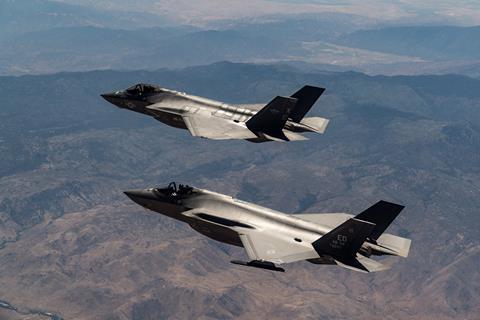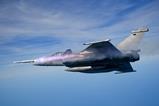The first parts for Germany’s lead Lockheed Martin F-35A will enter the assembly process at the company’s Marietta site in Georgia in the fourth quarter of this year, ahead of deliveries starting in 2026.
Work will begin on assembling the forward bulkhead section for aircraft MG01 in November or December, JR McDonald, Lockheed’s vice-president F-35 business development, tells FlightGlobal. The structure will later be shipped to its Fort Worth final assembly facility in Texas.
Being acquired via the US Foreign Military Sales mechanism, Germany’s 35 stealth fighters will be provided starting from the programme’s Lot 18 of production.

The first six aircraft are due to be handed over by October 2026, with these and two others to remain in the USA to support training activities at Ebbing Field Air National Guard base in Arkansas.
A first arrival in Germany will take place in 2027, and the air force’s full complement of the type will be delivered by 2029. This is in line with the Luftwaffe’s plan to retire the last of its Panavia Tornado strike aircraft in 2030.
McDonald says the German air force’s F-35As will be “dual-capable” – referring to their ability to perform both conventional and nuclear strikes. Berlin is acquiring the type to maintain its nuclear deterrent commitment to NATO, with the aircraft able to deploy the B61 bomb.
“That work is complete and the aircraft is now certified,” McDonald says of nuclear weapons integration with the F-35. “The Dutch are on that process right now as well,” he adds of moves to also make the capability available for European NATO nations.
Meanwhile, McDonald says Lockheed remains on track to resume F-35 deliveries in the third quarter of this year, once it has secured sign-off for the delayed Technology Refresh 3 (TR-3) standard.
“We have a plan for deliveries in the 75 to 110 range this year, and we are on track to do so,” he said at the ILA Berlin air show on 6 June. No examples of the stealth fighter were handed over during the first six months of 2024.
“Beyond that, we will start delivering those aircraft that have been waiting for that approval, so next year you will see a larger number,” McDonald says. Lockheed has continued building the type at its full rate of around 156 per year since the US Department of Defense and international customers halted deliveries due to incomplete TR-3 testing.
“We are in the final stages of the TR-3 certification,” he says, with flight testing ongoing. “The [system] stability is very close to what we expect it to be.”

Lockheed chief executive James Taiclet earlier this year outlined a stepped approach for the introduction of the TR-3 standard, starting with a so-called “combat training” version to be fielded from the third-quarter.
“TR-3 is not a dirty word. TR-3 is absolutely amazing – it’s what keeps the airplane significantly ahead of the threat for the next many years,” he says, since it will provide the foundation for the F-35’s future Block 4 standard. That process will deliver 75 major upgrades, across sensors, weapons integration and interconnectivity.
Meanwhile, Lockheed is eyeing additional sales of the F-35 in Europe, with Greece and Romania “working through the LOI [letter of intent] process”.
Lockheed projects that there will be potentially 650 F-35s in service with European customers by 2035, providing critical mass as next-generation combat air programmes mature.
“The number one consideration is to stay ahead of the threat,” he says, noting that Europe’s two such development efforts are only due to start delivering capability from 2035 and 2040, respectively.
“How long before there are enough of those [sixth-generation fighters] that you have a fleet that is tactically significant? Now we’re at 2040, 2045 or maybe 2050.
“That tells me that for the next 25 years you’re going to fight with F-35 against the threat. So you had better make sure you have got the right F-35s, you have got enough of them and you have kept them modernised.”
The US Air Force demonstrated the F-35A in the daily flying display at ILA for the first time during this year’s 5-9 June event, using an example drawn from Lakenheath in the UK.































